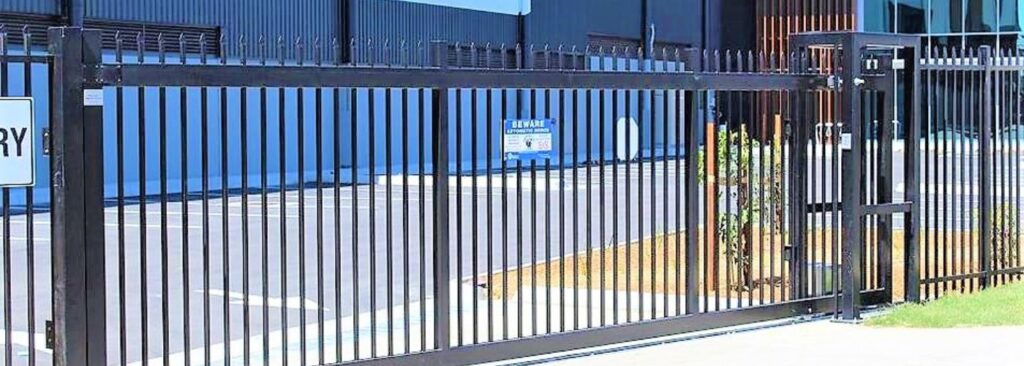
Sliding Gates: The Perfect Fusion of Security and Elegance #
Introduction Sliding gates, a popular choice for modern properties, are ingenious and stylish solutions that enhance security while adding an element of elegance. Whether you’re looking to secure your residential property or safeguard a commercial establishment, sliding gates offer practicality, aesthetics, and convenience. In this article, we will explore the various types of sliding gates, their components, advantages, installation, automation, safety measures, troubleshooting, customization, environmental considerations, and how they compare to other gate types. Let’s embark on a journey through the world of sliding gates! Types of Sliding Gates Sliding gates come in different designs to suit various needs and spaces. Single-panel sliding gates are simple and ideal for smaller openings, while bi-parting sliding gates are suitable for larger entrances. For areas with limited lateral space, cantilever sliding gates are the perfect solution, while telescopic sliding gates are excellent for maximizing the use of narrow openings. Components of Sliding Gates Understanding the components of sliding gates is crucial for appreciating their functionality. Gate panels and frames provide the structure, while rollers and bearings facilitate smooth movement. The track system ensures proper gate alignment and distribution of weight. Gate motors and automation allow for effortless operation, and safety features such as photoelectric sensors and safety edges protect users from accidents. Advantages of Sliding Gates Sliding gates offer an array of benefits that make them a preferred choice. Their space-efficient design is ideal for properties with limited space, and they provide enhanced security, deterring unauthorized access. Beyond functionality, sliding gates can be customized to complement the property’s aesthetics, and their sturdy construction ensures longevity with minimal maintenance. Choosing the Right Sliding Gate Selecting the most suitable sliding gate requires considering the property’s specific requirements. Factors such as available space, security needs, and budget play a significant role in choosing the right gate type and material. Installation and Maintenance A successful sliding gate installation involves meticulous preparation and professional execution. From assessing the site to concrete foundation work, each step is crucial for optimal performance. Regular maintenance, including cleaning and lubrication, ensures the gate’s smooth operation and longevity. Automating Sliding Gates Automation takes sliding gates to the next level of convenience. Automated gates can be controlled remotely, allowing homeowners and business owners to manage access from the comfort of their location. Integration with security systems further enhances property protection. Safety Measures Safety is paramount when it comes to sliding gates. Photoelectric sensors detect obstructions and prevent the gate from closing, while safety edges reverse the gate’s movement if it encounters an obstacle. Visible warning signs and lights add an extra layer of safety. Common Issues and Troubleshooting Despite their reliability, sliding gates may encounter occasional issues. If the gate gets stuck or goes off-track, a professional inspection and adjustment are necessary. Motor malfunctions and sensor problems can also be resolved with proper troubleshooting. Enhancing Security with Sliding Gates To fortify property security, sliding gates can be integrated with advanced access control systems, intercoms, and cameras. Seamless integration with smart home technology allows for remote monitoring and control. Customization and Aesthetics Sliding gates come in various materials and designs, providing ample opportunities for customization. Powder coating and finishes not only add aesthetic appeal but also enhance the gate’s durability. Environmental Considerations Concerns for environmental sustainability have driven innovations in gate systems. Opting for eco-friendly materials and solar-powered gate systems helps reduce the carbon footprint and lowers energy costs. Comparison with Other Gate Types Comparing sliding gates with swing gates and overhead (rolling) gates sheds light on their unique advantages and suitability for different applications. Case Studies Examining real-life examples of residential and commercial sliding gate installations showcases the practical applications and benefits of sliding gates in various settings. Conclusion Sliding gates embody a harmonious balance of security, functionality, and beauty. With their diverse range of designs, automation capabilities, safety features, and environmental considerations, sliding gates continue to be a compelling choice for modern properties. Whether for residential or commercial use, sliding gates exemplify the perfect fusion of security and elegance, providing peace of mind and a welcoming entrance.FAQs about Sliding Gates 1. Are sliding gates suitable for all types of properties? Sliding gates are versatile and can be adapted to various property types, including residential, commercial, and industrial. 2. Can sliding gates be customized to match my property’s aesthetics? Yes, sliding gates offer a wide range of customization options, including materials, colors, and designs. 3. Are sliding gates noisy during operation? With proper maintenance and quality components, sliding gates can operate quietly and smoothly. 4. How do I know if my property has enough space for a sliding gate? Professional gate installers can assess your property and advise on the most suitable gate type based on available space. 5. Are sliding gates secure against intruders? Sliding gates provide an added layer of security, especially when combined with access control systems and surveillance technologies.




